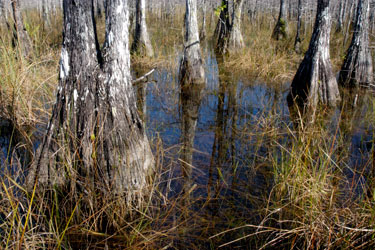
|

Cypress Swamp
While cypress swamps are most conspicuous in the aptly named Big Cypress National Preserve adjacent to Everglades National Park, they exist throughout the southern Everglades region as well. Within Everglades National Park, cypress is most visible from areas such as the Pa-hay-okee overlook, as well as along both sides of the road where the highway crosses the Dwarf Cypress Forest. Dwarf cypress are actually bald cypress whose growth has been stunted due to fire and low nutrient availability. These dwarf cypress with horizontal knobby branches are often nicknamed “hat rack” cypress. In Big Cypress National Preserve and the surrounding areas which make up the Big Cypress Swamp, floral diversity is much higher than in the Everglades. This region has a much shallower soil and more complex bedrock leading to many different types of communities throughout the region. Cypress domes, like those formed in Everglades National Park, dominate the landscape and are much larger in this region. Areas of ridges with upland communities such as pinelands and hammocks as well as lowlands with sloughs, strands, and other areas of deeper water form boundaries between the cypress domes. From the air these different communities often look like rolling hills as one community transitions into another. Like the pine ridge of the eastern Everglades, the mixed forests of the Big Cypress Swamp also have a high concentration of endemic and endangered species. Many of these plants have tropical origins and have evolved in very small communities creating high species diversity. Of special note to botanists and visitors are the high number of bromeliads, orchids, and other spectacular tropical plants found in this region. |
